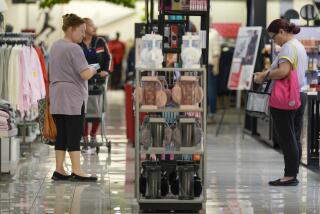Consumer spending rises in July, cutting into savings
Reporting from Washington — The savings rate for U.S. households fell in July to the lowest level in three months as spending outpaced income, the Commerce Department estimated Monday.
The savings rate fell to 5.9% from 6.2% in June, which had been the highest level in a year. Consumer spending rose 0.4% in July while personal income increased 0.2%.
Federal Reserve Chairman Ben S. Bernanke singled out the higher savings rate as a key factor in slower-than-expected economic growth for the second quarter. Spending should pick up as consumers make headway in repairing their balance sheets, he said.
Many economists are less optimistic, however. The high savings rate might not be an aberration but a longer-term trend, Harvard economics professor Martin Feldstein said.
The savings rate averaged only 2.1% in 2007, before the recession.
Incomes rose less than the 0.3% expected, while spending was stronger than the 0.3% gain expected by economists surveyed by MarketWatch.
Inflation-adjusted, or real, spending increased a seasonally adjusted 0.2% in July after a 0.1% gain in June, led by a sizable increase in purchases of durable goods. Real after-tax incomes fell 0.1% in July in the first decline since January, compared with a downwardly revised 0.1% gain in disposable incomes for June.
Peter Newland, an economist at Barclays Capital, called the gain in spending “a solid start” to the third quarter and said it “supports our view that consumer spending will continue to recover, albeit modestly, supported by a gradual improvement in labor income.”
Julia Coronado, an economist at BNP Paribas, was not so upbeat.
“Overall, the first month of the third quarter looks much like the second quarter, which is to say that consumers are spending, but slowly, and we expect spending growth below 2.0% quarter-over-quarter, seasonally adjusted annual rate for the third quarter as a whole,” Coronado wrote in a note to clients.
Although inflation has been trending lower over the last year, there was not much sign of further decline in the latest data.
Consumer prices rose 0.2% in July, as measured by the personal consumption expenditure price index. Prices are up 1.5% compared with the year before, up from the 1.4% rate for the 12 months through June.
Core consumer prices — which exclude volatile food and energy prices — rose 0.1% in July and are up 1.4% in the last year. Core inflation has been treading water near a 1.5% year-on-year growth rate since April.
Income from wages and salaries increased 0.3% in July, reversing course after a 0.1% drop in June. Income from assets such as dividends and interest fell 0.2%, the second straight monthly decline. Income from transfer payments, which are government payments such as Social Security and unemployment compensation, increased 0.3% for the second consecutive month.
Personal taxes increased 1.1% last month, the biggest gain since January.
Robb writes for MarketWatch.com/McClatchy.










